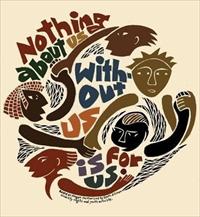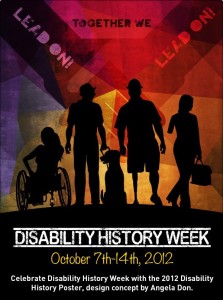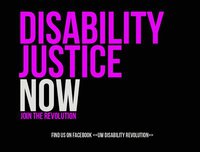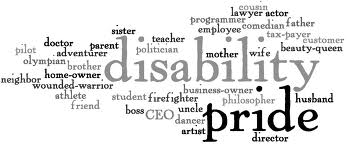The Problem with Person-First Language: What’s Wrong with This Picture?
Source: Facebook
This graphic came across my Facebook page in April. It took me some time to discern all the things about it that are problematic.
At first, all I could see was a problem with the intent of the text: the idea that one has to choose between seeing the person and seeing the disability. Why should that be a choice? My immediate response was to reframe it as follows:
See BOTH the person AND the disability. Because there is nothing dehumanizing or shameful about a disability.
My rewriting speaks to the heart of the problem with person-first language and its insistence on turns of phrase like “person with disabilities” rather than “disabled person.” Such language betrays the assumption that disability renders one less of a person. If that assumption were not present, there would be no reason to foreground the fact that we really, really, really are people, and that one has to put the disability aside in order to see how really, really, really human we are. Of course, that rather problematic logic begs the question: How exactly does one pretend not to see a disability once it has made itself known? In most contexts, that would be called denial.
Once I got done with the text, I thought I had reached the limit of what was wrong with the graphic. But over time, I noticed something else. Barely visible behind each of the standing figures is the shadow outline of a person in a wheelchair (symbolizing the “disability,” despite the fact that most disabled people do not use wheelchairs), while the “person” (whom we are supposed to “see”) is standing up on two feet.
In other words, being a person means being able-bodied. This assumption is hidden inside person-first language as well. After all, if I’m a “person with disabilities,” and you don’t look at the disabilities, then what I am without them? I’m able-bodied. Why? Because the very definition of able-bodied is to be without disability. Without the construct of disability, the word “able-bodied” would have no meaning at all.
But there is a third problem with the graphic, having to do with the way it represents and organizes the figures by gender. If you’ll notice, no two people of the same gender are next to each other. All the pairings are male-female. And all the figures fit into the gender binary, leaving no room for people who do not — which gets me to thinking, that if you put a genderqueer symbol in shadow behind each figure, you’d have an equivalent graphic for “See the Person, Not the Genderqueerness.” And in the logic of the graphic, a genderqueer person wearing a dress would be a woman, and a genderqueer person wearing pants would be a man.
I want to make clear that I am not against the use of person-first language. For the sake of variety in my writing, I sometimes use it, and I don’t mind it when others do. I don’t feel particularly inclined to interfere with the decisions that disabled people make regarding self-identification. To me, whether a disabled person self-identifies as differently abled, or a person with disabilities, or disabled matters not at all. I can argue the merits and the implications of different kinds of language, but if I’m talking with people who consider themselves differently abled, and that turn of phrase helps them move with some modicum of power and self-esteem through a world that considers them of lesser worth, I will respect where they are in their process, and I will address them as they wish to be addressed.
So it is not so much person-first language that I object to as the insistence, in some quarters, that people should always use person-first language, and that it is always more respectful than identity-first language. When I first set up my Autism and Empathy site, for example, one reader told me, quite vehemently and angrily, that I absolutely should not use the term autistic, that it was dehumanizing, and that I should always say person with autism; she was quite upset with me when I used the terms interchangeably. This imperative to always use person-first language is mirrored in the graphic, along with the rationale that underlies that imperative. It’s not that person-first language is good or bad, in and of itself. It’s that the rationale for its sole use as a respectful means of address perpetuates the idea that there is something shameful and dehumanizing about disability. It’s that particular way of looking at disability that needs addressing.
When all is said and done, the slogan of “See the Person, Not the Disability,” is based on the premise that disability can be separated from the person, leaving only that person’s humanity. The problem with this line of reasoning, of course, is that disability is inseparable from humanity. We all have bodies that are diverse, that are created in ways beyond our control, that change without our consent, and that are vulnerable to age, to accident, to illness, and to all of the contingencies of life. So if you want to see the whole person, look carefully at the disability, because that is where a core feature of our humanity lies.
—
Note: This post is a revised version of a piece on person-first language that I wrote for Journeys with Autism in April. The revised post incorporates some clarifications and reflections that came out of the discussion on the original piece.
© 2012 by Rachel Cohen-Rottenberg










Niksmom
5/31/2012 | 9:41 am Permalink
Rachel, thank you so much for this wonderful perspective. I’ve struggled with what to use or how to use it for these very reasons. My son is, quite simply, my son. He is an amazing boy who can do so many things both in spite of and because of his disabilities. I love this.
Jim W.
5/31/2012 | 11:41 am Permalink
You are SO much more succinct than I am.
eliza
5/31/2012 | 1:43 pm Permalink
I like what you said, it makes what I say so much easier. I find it odd how our culture that is so rich is constantly at war with itself. Who says we need to identify at all. I spent half my life trying to prove my disability both to the goverment and to the culture. I think that as long as we devide and segregate each other we remain lost and open to futher segregation by society as a whole. Just some thoughts your article inspired.
Naomi
5/31/2012 | 6:35 pm Permalink
Hi, thanks so much for this thoughtful piece! I’ve linked to it on my blog.
Emma Goldman
5/31/2012 | 8:30 pm Permalink
Thanks so much for your thoughtful piece. I so agree – what’s wrong with seeing the person AND her disability? Otherwise, you’re not seeing the person in their totality. The admonition to see the person not the disability would be like saying of an African-American, “See the person, not the skin color.” Obviously the two are inseparable.
Peggy Wallace
5/31/2012 | 8:53 pm Permalink
Thank you for your thoughtful writing about Person-First. That phrase caught my eye because I am a “Person First” trainer in a retirement community with three levels of care: independent living, assisted living, and a health care center. We have embarked on an ambitious years long culture change that brings dementia out of the health care center only and moves it into the center of our community, as well as helping staff see patients as persons and not as just “old people with problems.” Each trainer pairs with a staff member, or an independent living person. We teach both in the health center and in the assisted living center. It has been a difficult change for all of us, but most well accepted and loved in the health care center. I invite you to read about it at our website http://www.pilgrimplace.org. Keep up your awareness work!
Peggy Wallace
Colleen T
5/31/2012 | 9:33 pm Permalink
I think that it is appropriate for a person to use whatever they want to use to refer to themselves or others that have similar characteristics. Just as some minorities may use words to describe themselves with pride and rightfully so. However, when certain words are used by others outside of a select population to describe others viewed as different, they can then become dehumanizing because the words can have negative connotations that are implied by their use. I very much could see the benefit to my son to insist that the school first refereed to him by name only and then second when needed to state his disability as something he has. Because when others use disability terms or categories it isn’t often with the notion of pride or seeing the person as a whole person, our insistence did help others view him in a more positive light and accept him for who he is. My concern is the intent of the person using the words, if it is for pride, self-identification and in a positive context, then great, but often the media and others are using terms to describe people negatively, as limited and not whole, and perpetuating stereotypes.
Bob Bennett
5/31/2012 | 10:41 pm Permalink
Of course, the largest unrecognized disability is the closed mindedness of the many who consider themselves ‘normal’.
Trance
6/2/2012 | 10:19 pm Permalink
Yes. Neurotypical empathy is NOT the be all, end all of empathy. It’s limited.
EB
6/1/2012 | 10:33 am Permalink
On a related topic, it strikes me that some of the educational and therapeutic interventions that are devised for children with disabilities, particularly autism and/or cognitive disabilities, are so intense and so unremitting that they indicate an unwillingness to accept the child as s/he is. The goal seems to be to transform the child into one who is indistinguishable from children without disabilities. Of course we have to support high quality education for all children, but not at the price of refusing the reality of who the child is.
Jeff W.
6/1/2012 | 11:45 am Permalink
Yes and no. Yes – “See BOTH the person AND the disability. Because there is nothing dehumanizing or shameful about a disability.” But I don’t think it’s about denial. Artistically, this doesn’t work. This graphic is a commentary on our perceptions of the disabled. We take in so much of our information visually that it is easy to make judgements based upon appearance and forget that what makes a person a unique individual is so much more. This graphic is a reminder that we all need to love the whole person irrespective of any physical limitations. The shadows are an acknowledgement of the disability and an effective way of saying that it is part of who the person is, but not the primary defining characteristic of that person. As for the gender pairing statement, I think this is reading too much into it. Note that in every case, one figure is separated from the next by text of some sort. I don’t think any pairing is intended.
So in the end, I don’t think the graphic is about separating a person from a disability. It is about us perceiving the person first and the disability second – and not vice versa.
Haddayr
6/2/2012 | 1:30 pm Permalink
Jeff, I feel like that was the POINT of the graphic, but that it simply didn’t work, as it contained all of the unconscious background assumptions Rachel mentions.
lucia
2/17/2014 | 12:50 pm Permalink
it was the point of the graphic.. I am the designer of the shadowed disability symbol and you can read my response to this blog (which I have just discovered) here. http://allbigideas.blogspot.com/2014/02/representing-invisible-disability.html
Haddayr
6/2/2012 | 1:07 pm Permalink
HEAR, HEAR!
:fans you:
Nick
6/2/2012 | 10:03 pm Permalink
I think that identity-first language probably one of the best ways to go about using terms that relate to a person’s disability. I don’t typically call myself a “person with bipolar.” I don’t “suffer from bipolar.” I usually just say, “I’m bipolar.” It’s just a part of me. But it does make a difference in what other people’s use of the word is; a disability isn’t something that’s meant to be used as a joke. Getting back to identity-first language, it is important to get to know how a person addresses their own disability. I personally feel like mine is part of me, it has been for most of my life, and if I weren’t bipolar, I wouldn’t be me.
romham
6/3/2012 | 12:56 pm Permalink
Gah! i didnt even see the shadows til you mentioned them. Not a fan of this graphic or it’s message.
Too often people tell me “but I don’t see your disability!” and “I don’t think of you as disabled!”. It’s troubling for me because, well, hi denial; but also, it makes assumptions about what i have going on, people assume they know what my “disability” is, what it contains, and they’re wrong. I have disabilitIES, and they are varied; because there exists the one manifestation that most people can understand and recognize as “Disability(tm)” (i.e. being on wheels) doesn’t mean they have any understanding of what’s going on for me. Yet, without really much info at all, they are able to erase my reality as a gimp. Powerful.
And really annoying lol.
lucia
2/17/2014 | 12:51 pm Permalink
hi
I just discovered this blog and here is my response. it wasn’t meant in the way its been described in this blog. it was a reaction to exactly what you are saying